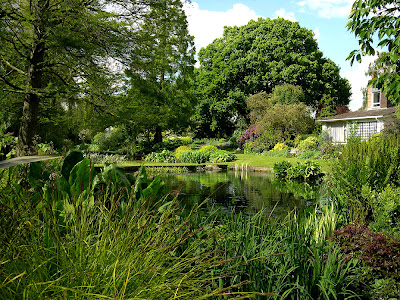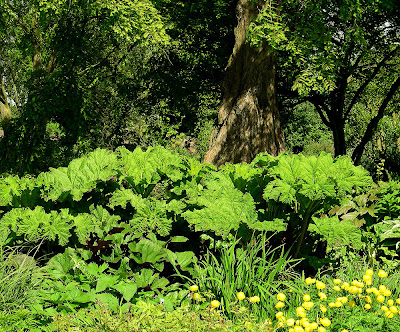In memoriam László Lukács S.J.
Today I finally made my order of clematis. An order like this is always preceded by a huge work. As the plants I order usually can be seen live the nearest five hundred kilometers to here, I try to get to establish via internet how they might look in the reality. The data of the same plant are often surprisingly different on the pages of different nurseries, thus one has to work usually quite much to have a realistic image.
Search and you shall find. Although not necessarily what you were looking for. In the eighties, on a traineeship in a small village in Western Hungary as an undergraduate of sociology I and a friend received the task to find out what and how was produced there at the beginning of the forties. The people we questioned started to count back, that before the war... but before which war... when the militiamen came... or when Anti was taken away... or else... And then they started to tell us about the militiamen and about who and how took away Anti and the rest. We never got to know what had been produced there, but in two days we knew everything about the past decades.
Later I made a lot of other interviews as well, and I experienced that at this part of the world any question you put, within five minutes you’ll be at the point of before which war... or when he was taken away...
I’m browsing among the clematis. One is more beautiful than the other.

After a while I discover that the most beautiful ones usually come from Poland, Estonia or Ukraine. And then I find the breeders as well.

Stefan Franczak S. J. from Poland.
How well I know this kind of face. This is the face of my Communist grandfather who, while we lived crowded in seven in a tiny flat of one room and one kitchen, refused the building land offered to him for an extremely low price, saying that “a Communist owns no land.”
The face of our neighbor Uncle Jani who, with his foot smashed to pieces at the Don river (of the two hundred thousand men sent there well if a tenth came back) even at the age of ninety cultivated their one hectare large garden in a way that there was not a single weed left in it.
The face of Lukács. In the Jesuit convent of Rome he galloped ahead on the long corridor like a big kangaroo, while I was following him at a brisk pace like a little rabbit to the lift, to go up to the fathers’ cafeteria on the fifth floor where he provided me and Tamás with coffee as a reward for the good job done in the library on that day. The Jesuit fathers – who either never knew or in the Roman comfort already forgot what was poverty like, that there is such a thing that one does not have money either for a coffee – did not cease to murmur. Lukács, however, was unperturbed. He was a conscious Socialist. Before the war — which one... the one in which the foot of Uncle Jani was smashed — his duty was to minister the small ranches on the plain around Szeged. He did know what poverty was.
After the war, at the command of his superiors, he escaped over the border. He was placed in the Historical Institute of the Jesuit order in Rome. In the morning he sat at his table, and there he worked until late night – apart from prayer and some afternoon nap he got accustomed to in Rome. Each day. For fifty years. He did not walk around in the city, he lived no social life. Although he could have done so. Others did so. He, however, only wanted to serve God by keeping alive the memory of the ancient Hungarian Jesuits. He collected every data about each Hungarian Jesuit from the 1500’s on. His results published in book mounted up to almost one running meter.
Then the times changed in Hungary, he was awarded several prizes, they wanted to make an idol out of him. But he was not touched by this. Before we left, we went up to his room. I was shocked to see the poverty in which he lived. A bed, a chair, a table with a computer on it – above eighty he learned how to use it, because with the help of it he could work quicker, on the greater glory of God –, a bookshelf and nothing else. By some miracle he nevertheless found a little medal so that he could give me a gift.
Before his death he came back home to Budapest for a short visit. He still could come out to see us in the garden.
Stefan Franczak is an internationally renowned clematis breeder. His name is connected with more than eighty breeds of clematis, many of which are awarded with international prizes. He published in several American, Canadian, British and Swiss reviews, and since the eighties there is no textbook that would not mention his work.
He was born in 1917. After studying and then teaching in various schools of agriculture, in 1948 he entered the Jesuit order as a simple helping brother. In Warsaw he was entrusted with the care of the one and half hectares large garden of the Jesuit college. As in the fifties the Communists preferred to expropriate the estates of the church upon the pretext of turning them for communitarian purposes, the Jesuits, in order to prevent this, converted their vegetable garden in a park and opened it to the public. This task was entrusted to him, too.

In a very short time he created an extensive ornamental garden composed of more than nine hundred plants, mostly breeds of clematis, iris and daylilies. Soon the whole country came to admire it, and specialists from all the world regularly made pilgrimage to it.
This picture, displaying a detail from the garden as it was in the seventies, could be published even today in any English garden review. But what it meant at
that time is only understood by those who remember that, when crossing the border eastward, immediately everything was filthy, ugly, colorless and abandoned – deliberately and on purpose. The beauty of this garden, created in the middle of state-supported destruction, was a constant protest against the barbarism of the regime.
But barbarians are everywhere. With the change of regime the Jesuits received permission to build a new church, and by 1996 they erected one, by thus reducing their garden to a third of its size. And this was not enough. In 2003 the rector of the Jesuit college decided to transfer the 86 years old Brother Stefan to another convent and to liquidate the garden, the result of the whole life of an internationally renowned flower breeder. He received more than sixty protest letters from all over the world. They did not count much. Albeit he has not transfered the old Jesuit, nevertheless by remaining there, he has to observe while the rector continuously and systematically destroys the rest of his garden.

Saint Teresa of Avila in 1572 or 1573 made the pledge below in a playful form, but with a very serious content. She presumably made it to the benefit of Jerónimo Gracián, who at that time accomplished his novitiate in Pastrana. After the death of Teresa and John of the Cross this very talented and devout priest was the only one who faithfully represented Teresa’s line of direction. And within some years those very superiors mentioned by Teresa below expelled him from the order, by employing even the most disgusting means. I do not know where these people are now, although we know the circumstances of the death of the biggest scoundrel – the superior general of the order of that time –, and those do not promise anything good. The canonization of Gracián, however, was recently begun by the Church. And Teresa already a long time ago stepped over to there where there are no barbarians and no scoundrels, where there is no pain and no destruction. And I think that by this her pledge too has turned timeless.
“Teresa de Jesús dice que da a cualquier cavallero de la Virgen que hiciere un acto solo cada día muy determinado a sufrir toda su vida un perlado muy necio y vicioso y comedor y mal acondicionado, el día que le hiciere la da la mitad de lo que mereciere aquel día, ansí en la comunión como en hartos dolores, que trai; en fin, en todo, que será harto poco, ha de considerar la humildad con que estuvo el Señor delante de los jueces y cómo fue obediente hasta muerte de cruz.”
(“Teresa of Jesus makes the pledge that to any knight of the Virgin who each day renews his intention to suffer throughout his whole life the power of a wicked, stupid, voracious and rude prelate, I hand over half of what I have merited on that day either in the community with God or in the hard sufferances taken by me. And in all this he has to consider that humility with which the Lord stood in front of his judges and how He was obedient until His death on the cross.”)

 class: English rose (David Austin 1994)
class: English rose (David Austin 1994)

 class: English rose (David Austin 1994)
class: English rose (David Austin 1994)















